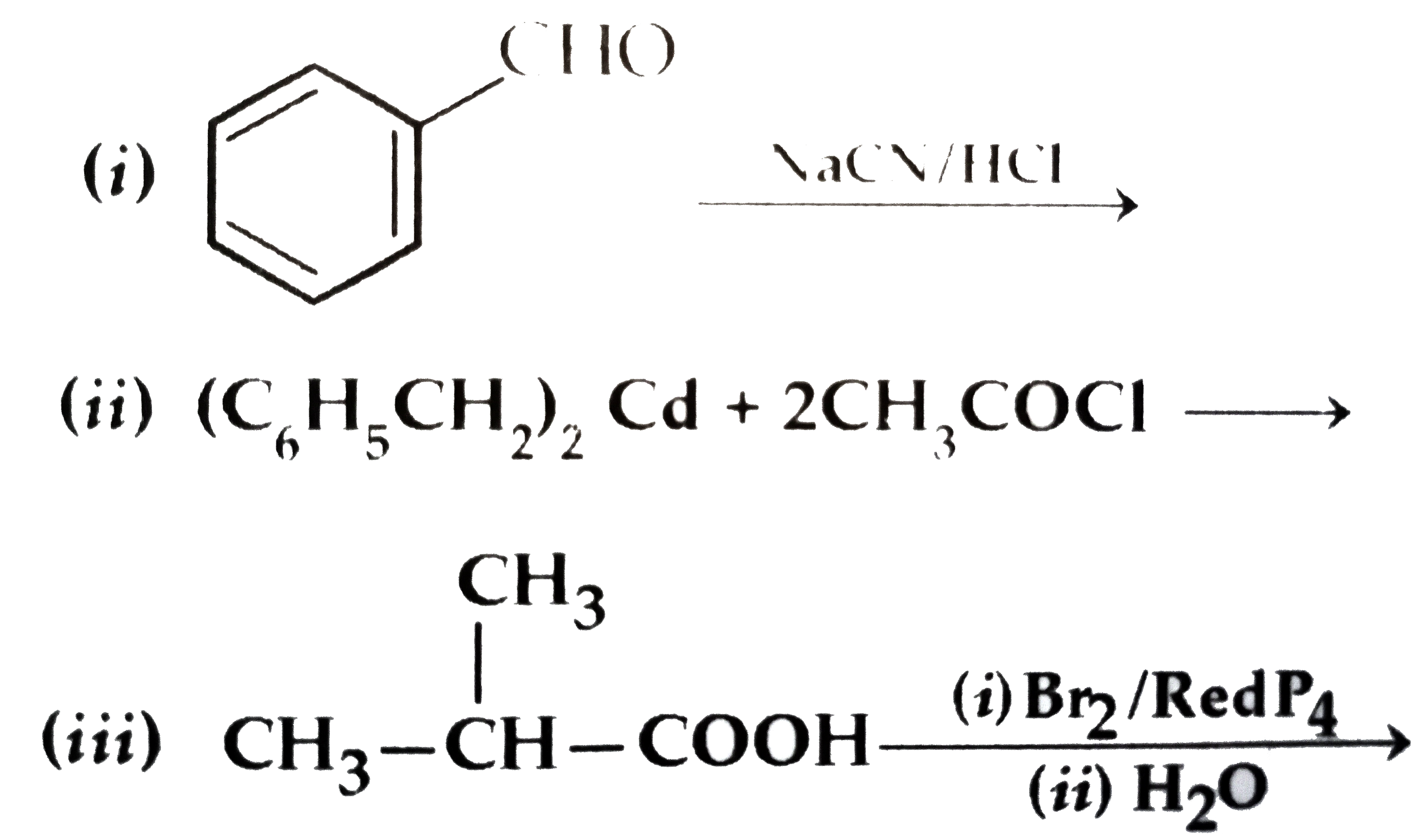Which one/ones of the following reactions will yield 2-propanol ?
(I) CH2=CH−CH3+H2OH+−−→
(II) CH3−CHO(i)CH3Mgl−−−−−−−→(ii)H2O
(III) CH2(i)C2H5MgI−−−−−−−→(ii)H2O
(IV) CH2=CH−CH3Neutral KMnO4−−−−−−−−−−→
I and II
II and III
I and III
II and IV
The correct Answer is:A
To determine which reactions yield 2-propanol, we will analyze each reaction step by step.
Step 1: Analyze Reaction I
Reaction I:
CH2=CH−CH3+H2OH+→
- This is an acid-catalyzed hydration of propene (CH₂=CH-CH₃).
- According to Markovnikov's rule, the hydrogen atom from water will add to the carbon with more hydrogen atoms (the terminal carbon), and the hydroxyl group (OH) will add to the carbon with fewer hydrogen atoms.
- The product formed will be:
CH3−CH(OH)−CH3
- This is 2-propanol.
Step 2: Analyze Reaction II
Reaction II:
CH3−CHO(i)CH3MgI→(ii)H2O→
- Here, acetaldehyde (CH₃CHO) reacts with a Grignard reagent (CH₃MgI).
- The Grignard reagent adds to the carbonyl carbon of acetaldehyde, forming a tertiary alcohol.
- The product formed after the addition of water will be:
CH3−CH(OH)−CH3
- This is also 2-propanol.
Step 3: Analyze Reaction III
Reaction III:
CH2+(i)C2H5MgI(ii)H2O→
- In this reaction, the Grignard reagent (C₂H₅MgI) adds to a carbon atom (not specified, assuming it is a carbonyl compound).
- The reaction does not specify the starting material clearly, but typically, if it were to add to a carbonyl compound, it would not yield 2-propanol.
- The product formed here would not be 2-propanol.
Step 4: Analyze Reaction IV
Reaction IV:
CH2=CH−CH3Neutral KMnO4→
- This is a reaction with neutral potassium permanganate (KMnO₄), which typically oxidizes alkenes.
- The product formed from this reaction would be:
CH3−CHOH−CHOH−CH3
- This is not 2-propanol, but rather a diol.
Conclusion
From the analysis:
- Reactions I and II yield 2-propanol.
- Reactions III and IV do not yield 2-propanol.
Final Answer
The reactions that yield 2-propanol are:
- (I) and (II).
---
Reaction I:
CH2=CH−CH3+H2OH+→
- According to Markovnikov's rule, the hydrogen atom from water will add to the carbon with more hydrogen atoms (the terminal carbon), and the hydroxyl group (OH) will add to the carbon with fewer hydrogen atoms.
- The product formed will be:
CH3−CH(OH)−CH3
- This is 2-propanol.
Reaction II:
CH3−CHO(i)CH3MgI→(ii)H2O→
- The Grignard reagent adds to the carbonyl carbon of acetaldehyde, forming a tertiary alcohol.
- The product formed after the addition of water will be:
CH3−CH(OH)−CH3
- This is also 2-propanol.
Reaction III:
CH2+(i)C2H5MgI(ii)H2O→
- The reaction does not specify the starting material clearly, but typically, if it were to add to a carbonyl compound, it would not yield 2-propanol.
- The product formed here would not be 2-propanol.
Reaction IV:
CH2=CH−CH3Neutral KMnO4→
- The product formed from this reaction would be:
CH3−CHOH−CHOH−CH3
- This is not 2-propanol, but rather a diol.
From the analysis:
- Reactions I and II yield 2-propanol.
- Reactions III and IV do not yield 2-propanol.
The reactions that yield 2-propanol are:
- (I) and (II).
Similar Questions
Which of the following reactions will yield propan-2-ol ? Select the right answer from (a), (b), (c) and (d)
I. CH2=CH−CH3+H2OH+−−→
II. CH3−CHOCH3MgI/H2O−−−−−−−−→
III. CH2OC2H5MgI−−−−−−−−→H2O
IV. CH2=CH−CH3Neutral KMnO4−−−−−−−−−−→
View SolutionWhich of the following is the correct ease of dehydration ?
I CH3−CH2−CH2−CH2∣OH , II CH3−CH2−OH∣CH−CH3 , III CH2=CH−OH∣CH−CH3, IV

View Solution
Knowledge Check
CH3−CH2−CH=CH2+CH2OHH⊕−−→CH3−CH2−CH∣OCH3−CH3
What is nucleophile in second step ?ACH3−CH2−CH=CH2BCH3OHCH2ODCH3−O−CH3CH3−CH2−CH=CH2+CH2OHH⊕−−→CH3−CH2−CH∣OCH3−CH3
What is nucleophile in first step?ACH3OHB1-buteneCH2ODCH3−O−CH3Which of the following compounds will give racemic mixture on nucleophilic substitution by OH− ion?
(I)CH3−CH∣C2H5−Br
(II) CH3−Br∣C∣C2H5−CH3
A(I)B(II)C(I),(II)DNone
Write structures of the products of the following reactions:
(i) CH3−CH=CH2H2O/H+−−−−−→
(ii)
(iii) CH3−CH2−C | CH3H−CHONaBH4−−−−→
View SolutionComplete the following reactions:
(i)
(ii) (C6H5CH2)2Cd+2CH3COC<o
(iii) CH3−CH3∣CH−COOH(i)Br2/RedP4−−−−−−−−−→(ii)H2O
View SolutionCH3CH∣CH3−CH=CH2(i)B2H4−−−−−−−−−→(ii)H2O2/OHXH2SO4−−−→140∘Y
What is Y ?
View SolutionCH3−CH2−CH2−C∣OHH−CH3 and CH3−CH2−C∣OHH−CH2−CH2−CH3 are
View SolutionThe major product of the following reaction is :
(CH3)2C=CH−CH2−CH3(i)B2H6,ether(ii)H2O2,NaOH−−−−−−−−−−−−−−−−−−−−→
View Solution
